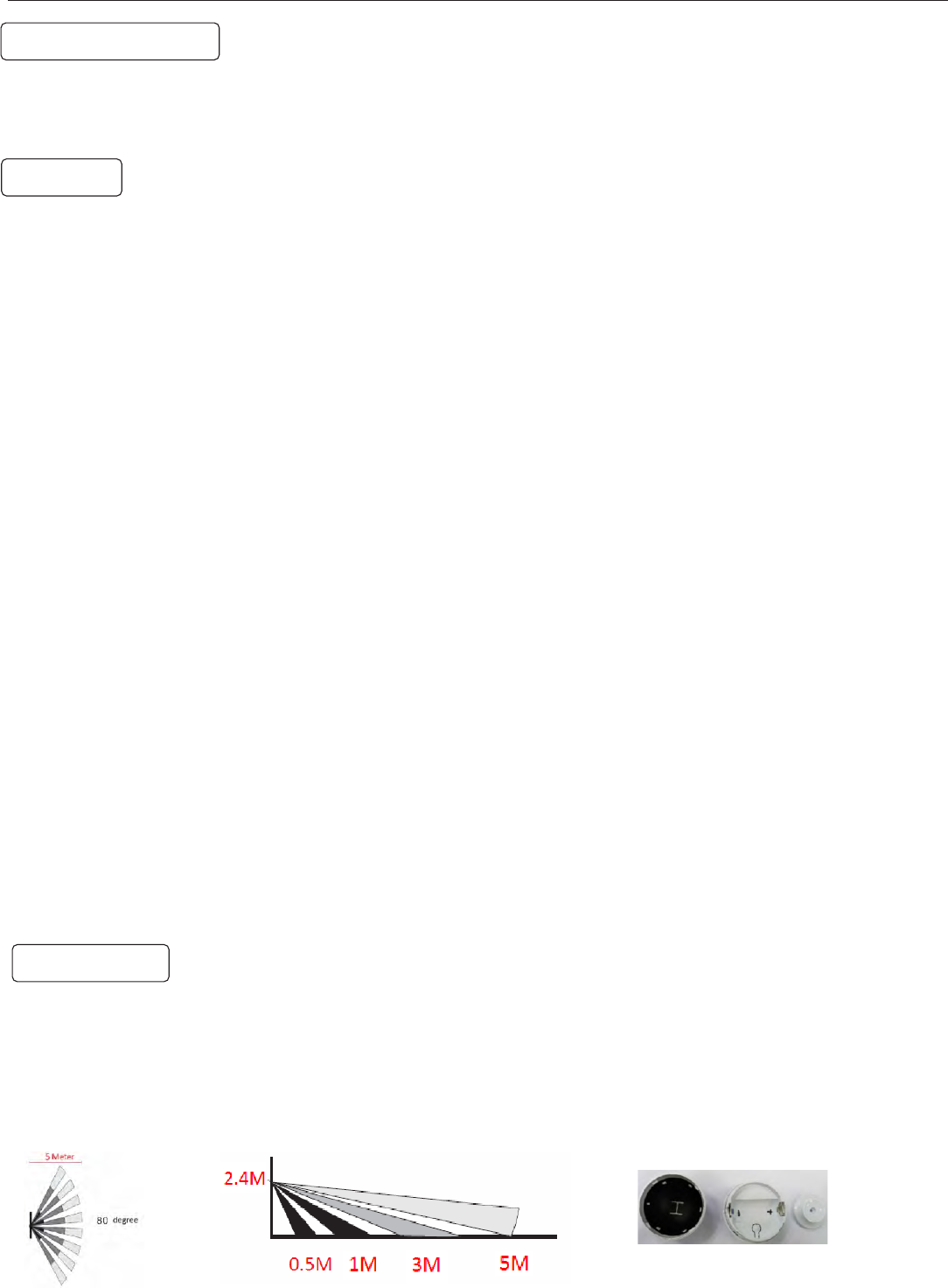Willis Electric ZW1102 PIR Sensor User Manual
Willis Electric Co., Ltd. PIR Sensor
User manual

FCC/IC
ZW1102 PIR Sensor
Show Home Products warrants this product to be free from manufacturing defects for
a period of two years from the original date of consumer purchase. This warranty is limited
to the repair or replacement of this product only and does not extend to consequential or
incidental damage to other products that may be used with this product.
This warranty is in lieu of all other warranties, expressed or implied. Some states do not
allow limitations on how long an implied warranty lasts or permit the exclusion or limitation
of incidental or consequential damage, so the above limitations may not apply to you.
This warranty gives you specific rights, and you may also have other rights which vary from
state to state. if the unit should prove defective within the warranty period.
RISK OF FIRE
RISK OF ELECTRICAL SHOCK
RISK OF BURNS
CONTROLLING APPLIANCES:
EXERCISE EXTREME CAUTION WHEN USING Z-WAVE
DEVICES TO CONTROL APPLIANCES. OPERATION
OF THE Z-WAVE DEVICE MAY BE IN A DIFFERENT
ROOM THAN THE CONTROLLED APPLIANCE, ALSO AN
UNINTENTIONAL ACTIVATION MAY OCCUR IF THE WRONG
BUTTON ON THE REMOTE IS PRESSED. Z-WAVE DEVICES
MAY AUTOMATICALLY BE POWERED ON DUE TO TIMED
EVENT PROGRAMMING. DEPENDING UPON THE APPLI-
ANCE, THESE UNATTENDED OR UNINTENTIONAL OP-
ERATIONS COULD POSSIBLY RESULT IN A HAZARDOUS
CONDITION. FOR THESE REASONS, WE RECOMMEND
DO NOT RETURN THIS PRODUCT TO THE STORE
THE FOLLOWING:
DO NOT USE Z-WAVE DEVICES TO CONTROL ELECTRIC
HEATERS OR ANY OTHER APPLIANCES WHICH MAY PRES-
ENT A HAZARDOUS CONDITION DUE TO UNATTENDED OR
UNINTENTIONAL OR AUTOMATIC POWER ON CONTROL.
WARNING
WARRANTY
Model:ZW1102
Power supply: battery CR123A, 3V.
Signal (Frequency): 908.42 MHz.
Operating Range: Up to 50M outdoor,up to 30M indoor
Operating Temp.: 0°C~40°C
Recommended installation height: 2.4M
Wireless Controller and the closest Z-Wave
receiver module.
Specifications subject to change without notice
due to continuing product improvement
SPECIFICATIONS
Website www.ishowlights.com
Federal Communications Commission (FCC) Statement
FCC Caution: Any changes or modifications not expressly approved by the party responsible for
compliance could void the user’s authority to operate this equipment.
This device complies with Part 15 of the FCC Rules. Operation is subject to the following two
conditions: (1) This device may not cause harmful interference, and (2) this device must accept any
interference received, including interference that may cause undesired operation.
NOTE: This equipment has been tested and found to comply with the limits for a Class B digital device,
pursuant to Part 15 of the FCC Rules. These limits are designed to provide reasonable protection
against harmful interference in a residential installation. This equipment generates, uses and can
radiate radio frequency energy and, if not installed and used in accordance with the instructions,
may caus harmful interference to radio communications.However, there is no guarantee that
interference will not occur in a particular installation. If this equipment does cause harmful interference
to radio or television reception, which can be determined by turning the equipment off and on,
the user is encouraged to try to correct the interference by one or more of the following measures:
Reorient or relocate the receiving antenna.Increase the separation between the equipment and
receiver.Connect the equipment into an outlet on a circuit different from that to which the receiver
is connected.Consult the dealer or an experienced radio/TV technician for help.This equipment
should be installed and operated with minimum distance 20cm between the radiator and your body.
IC Caution:
This device complies with Industry Canada licence-exempt RSS standard(s). Operation is subject
to the following two conditions: (1) this device may not cause interference, and (2) this device must
accept any interference, including interference that may cause undesired
operation of the device.
DECLARATION DE CONFORMITE D'INDUSTRIE CANADA
Ce périphérique a été testé et reconnu conforme aux limites spécifiées dans RSS-210.
Son utilisation est soumise aux deux conditions suivantes :
(1) il ne doit pas provoquer d'interférences gênantes et
(2) il doit tolérer les interférences re.ues, notamment cellessusceptibles d'en perturber le fonctionnement.

Instruction
.
1.Do not attempt to disassemble the PIR Sensor, unless described in the user’s manual. There are no user serviceable parts.
2.Handle with Care – Avoid striking or shaking. Improper use or storage could damage the PTR Sensor. Modifying or tampering
the device or its internal components can cause a malfunction and void the PIR Sensor’s warranty.
3.If you feel the PIR Sensor or any part of the Choice Alert system is not operating correctly or as described, please contact
The PIR Sensor is designed to be used indoors or out. When mounted properly it can monitor large or open areas such as
entrances, living rooms, family rooms, driveways, backyards, walkways, workshops, etc. When the Sensor detects motion, it
will transmit a signal to the Control Center. The Zone selection and settings on the Control Center determine if an alarm or an
alert sounds.
1.The PIR Sensor consists of 2 parts – The Sensor(Transmitter) and the wall mount. Before installing, remove the the battery
of the Sensor. You’ll need to attach the battery leads to CR123A 3V battery; Take care to note the polarity markings. Replace
the battery cover and secure screw. battery in the PIR Sensor can last up to 9 months.
Preparing the PIR Sensor for Installation
Detection pattern:
100degree 5x5M at 25°C
Top view
Side View
Important safeguards
Package content
PIR Sensor - 1pcs
Magnet bracket - 1pcs
Battery CR123A - 1pcs
Screw - 2pcs
Low Battery Indicator
The Control Center continuously monitors all the Sensors. If the Control Center does not
receive a signal from any Sensor it will begin rapidly flashing the Zone LED indicator . This
indicates one or more Sensors in the Zone may have low battery power and are unable
to transmit a signal the necessary distance. If all batteries and/or Sensors are installed
at the same time into a Zone, it is recommended to replace the batteries in all Sensors in the
Zone. However, you can check the PIR Sensor status independently by placing the Control
Center in Test mode (see Testing a Sensor on page 7) and trigger the Sensor separately.
If mounted, wave hand in front of Sensor, or press activation button for two seconds inside
battery compartment. If the Sensor does not trigger an alert then replace the battery with a
new one.
Note: The Sensor detection system is ‘range dependant’, which means Sensors located
closer to the Control Center may seem to have batteries that last longer than those Sensors
at a greater distance. Also, keep in mind, because the Motion Sensor is continually checking
for activity the battery life is less than the lithium cell batteries in the other Sensors.
3.Erasing the Sensor from a Zone
If you need to remove the Sensor from a Zone, the system will erase the entire Zone, so any other Sensors will need to be put
back into that particular Zone.Step 1 - To erase a Zone, press and hold the Learn button on the Control Center. The unit will
beep once.Step 2 - While holding the Learn button, press and hold the Zone button to be erased. After five seconds the Control
Center will sound two beeps and the Zone LED indicator will flash twice.Step 3 - Release all buttons. The Zone has been erased.
and delay time for next Trigger : 35 sec.
Note: The Zone/PIR Sensor cannot be erased if:
The Zone has been triggered for an Alert or alarm. The Sensor/Zone must be reset. There is loss of signal from the Sensor to
the Control Center (such as low battery, or Sensor is out of range).The system is armed. The Control Center will sound three
beeps to indicate it could not erase the Zone.
2.Use the ball-head mount to mount the Sensor. The minimum spacing recommended is 5-6 ft, depending on where you want to
mount the PIR Sensor. Once the location is selected, before mounting you should perform a manual test to confirm the
PIR Sensor is within range of Control Center. Refer to the Testing a Sensor section on pg 7. Mount the ball-head joint to
the location with screws provided. Once the ball-head joint is mounted to the wall, slide the back of the sensor onto the
ball-head joint. The mounting angle can be adjusted.